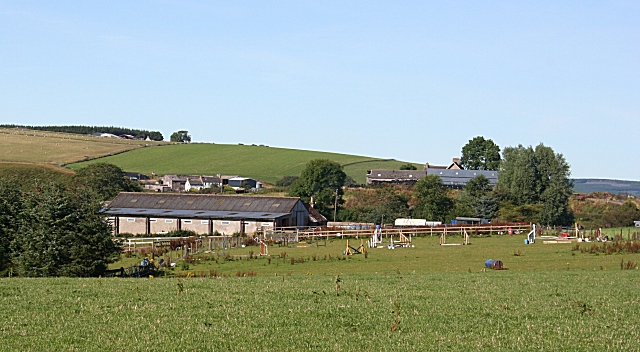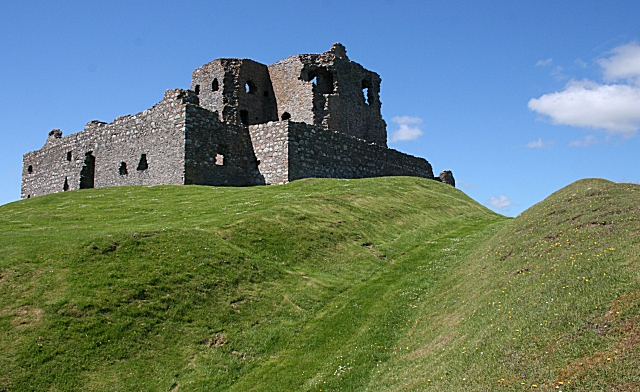|
Boharm
Boharm is a rural parish in the Speyside area of north Scotland, midway between Aberlour and Fochabers, and north of Dufftown. It lies on minor roads to either side of the A95. The main settlements in the parish are Maggieknockater and Mulben. Despite its tiny size it is linked to two men who have been Moderator of the General Assembly, the highest position in the Church of Scotland. A distinctly rural parish it consists mainly of farm estates and has no village centre as such. The parish has an area of . History The settlement was originally called Bocharin, meaning a bow-shape around a cairn or rocky hill, the hill in question being Ben Aigan, east of the River Spey and Rothes. In his article on the parish for the Statistical Account of Scotland, 1791–9, Rev Lewis Forbes describes it thus: The length, between the parish of Mortlich, at the west, and the parish of Bellie, at the east, is from 7 to 9 English miles; the breadth, from the parish of Botriphnie, at the s ... [...More Info...] [...Related Items...] OR: [Wikipedia] [Google] [Baidu] |
Lewis William Forbes
Lewis William Forbes (1794–1854) was a Scottish minister who served as Moderator of the General Assembly of the Church of Scotland in 1852, the highest position in the Church of Scotland Life He was born in Banff, Aberdeenshire on 16 August 1794. He was minister of Boharm, a small parish south of Fochabers in rural Banffshire, for 37 years. He died at the Church on 8 January 1854. He is buried in Boharm Churchyard. Family He was married twice. His first wife was Penelope Cowie. His son, Archibald Forbes (1838–1900), was a famous war correspondent. His daughter Margaret Chalmers Forbes (1821–1903) married the Very Rev William Robinson Pirie (1804–1885), Moderator in 1864. They had eight children. She is buried in Old Machar Churchyard in Aberdeen. His second son, George Cowie Forbes, trained as a doctor and emigrated to the United States, dying in San Francisco San Francisco (; Spanish language, Spanish for "Francis of Assisi, Saint Francis") ... [...More Info...] [...Related Items...] OR: [Wikipedia] [Google] [Baidu] |
David McDowall-Grant
David McDowall Grant (20 July 1761 – 27 June 1841), of Arndilly, Banff and Barr House, Lochwinnoch, was a Scottish naval officer, collector of customs and, briefly, Member of Parliament. He was the 5th surviving son of William McDowall, Member of Parliament for Renfrewshire from 1768 to 1774, and Elizabeth Graham. His eldest brother, William McDowall, was also a Member of Parliament for Renfrewshire, Ayrshire and the Glasgow Burghs, and another elder brother, Hay MacDowall was a Lieutenant General and General Officer Commanding, Ceylon . In 1790 he married Eleanor Mary, daughter and heir of Col. Alexander Grant of Arndilly, taking the additional name of Grant. He was returned as Member of Parliament for Banffshire in 1795 following the resignation of Sir James Grant, but is not recorded as having spoken or voted, and did not seek election at the 1796 general election. He entered the navy around 1778, and was promoted to lieutenant in 1781, retiring as a commander in 1816. ... [...More Info...] [...Related Items...] OR: [Wikipedia] [Google] [Baidu] |
William De Moravia Of Petty
William de Moravia (died c. 1226), Lord of Petty, Bracholy, Boharm and Arteldol, was a Scottish noble. He was the second son of William, son of Freskin. His elder brother was Hugh de Moravia of Duffus and Strathbrock. William gifted the church of Artendol to the Cathedrals of Spynie and Elgin. He was appointed as Sheriff of Inverness and Nairn in 1204. William built the chapel of Galival, near Gauldwell Castle prior to 1222. He died before October 1226. Marriage and issue William, married a daughter of David de Olifard, they are known to have had the following issue:Burke, John. ''A genealogical and heraldic history of the commoners of Great Britain and Ireland.'' 1833. pp. 619–620 * Walter de Moray (died c. 1278), married a daughter of Máel Coluim II, Earl of Fife, had issue. *William de Moravia, Canon Canon or Canons may refer to: Arts and entertainment * Canon (fiction), the conceptual material accepted as official in a fictional universe by its fan base * Lit ... [...More Info...] [...Related Items...] OR: [Wikipedia] [Google] [Baidu] |
Patrick Forbes (minister)
Patrick Forbes (1776–1847) was a Scottish minister who served as Moderator of the General Assembly of the Church of Scotland for the period 1829 to 1830. He was Professor of Humanities and Chemistry at the University of Aberdeen. Life He was born in Aberdeen on 17 June 1776 the son of Rev Francis Forbes of Camphill, and his first wife, Isabella Copland. He was elder half-brother to Sir Francis William Forbes, Chief Justice of Newfoundland. He studied at Marischal College in Aberdeen graduating MA in 1793. In 1793/4 he was schoolmaster of Grange. He was licensed to preach by the Presbytery of Strathbogie in 1797. He was minister of Boharm from 1800 to 1816 but moved to Old Machar in Aberdeen where he remained for most of his adult life, and from 1816 he was also professor of both Humanity and Chemistry at King's College, Aberdeen, replacing Prof Ogilvie. In 1828 he succeeded Stevenson McGill as Moderator of the General Assembly, the highest position within the Church o ... [...More Info...] [...Related Items...] OR: [Wikipedia] [Google] [Baidu] |
Arndilly House
Arndilly House is a 1770 house in Banffshire, Scotland, in the parish of Boharm. It lies between the River Spey and Ben Aigan. It was remodelled in both 1826 and 1850. It is a category A listed building with Historic Scotland Historic Scotland ( gd, Alba Aosmhor) was an executive agency of the Scottish Office and later the Scottish Government from 1991 to 2015, responsible for safeguarding Scotland's built heritage, and promoting its understanding and enjoyment. .... It was remodelled in the Scots baronial style in 1850 by the Aberdeen architect James Matthews. It was the seat of the MacDowall Grant family in the 18th and 19th centuries, including David McDowall-Grant. References External linksOfficial website [...More Info...] [...Related Items...] OR: [Wikipedia] [Google] [Baidu] |
Auchindoun Castle
Auchindoun Castle is a 15th-century L-Plan tower castle located in Auchindoun near Dufftown in Banffshire, Scotland. History While there is evidence of prehistoric or Pictish earthworks in the grounds of the castle, the remains most visible today are of the castle constructed in the mid-15th century. This building is sometimes said to be the work of Robert Cochrane, a favourite of James III. It passed to the Clan Ogilvy in 1489 and from them to the Clan Gordon in 1535.Coventry (2008). p. 228. There are accounts, including by William Forbes Skene and Alexander Macbain, that state that William Mackintosh, 15th of Mackintosh had burned the Earl of Huntly's Auchindoun Castle which is why Huntly had him executed in 1550. However, Alexander Mackintosh-Shaw states that this story is entirely fictitious. The castle was damaged by the Clan Mackintosh in 1592 in retaliation for Huntly's killing of the '' Bonny Earl O'Moray'', their ally. In March 1593 Patrick Gordon of Auchindoun ... [...More Info...] [...Related Items...] OR: [Wikipedia] [Google] [Baidu] |
Balvenie Castle
Balvenie Castle is a ruined castle 1 km north of Dufftown in the Moray region of Scotland. History Originally known as ''Mortlach'', it was built in the 12th century by a branch of the powerful Comyn family (the ''Black Comyns'') and was extended and altered in the 15th and 16th centuries. The castle fell out of use following an attack by Robert the Bruce in 1308, which left the property uninhabitable. At some point in the 14th century, the castle and estates of Balvenie passed to the Earl of Douglas. Nothing is documented as to how the Black Douglases first acquired the castle but the most likely account is that it came with the marriage of the heiress Joanna Murray to Archibald '' 'the Grim' '', 3rd Earl of Douglas in 1362. His son and successor Archibald Douglas, 4th Earl of Douglas granted his younger brother James Douglas, 7th Earl of Douglas, latterly known as James '' 'the Gross' '', the lordship of Balvenie in 1408. James's main residence was at Abercorn Ca ... [...More Info...] [...Related Items...] OR: [Wikipedia] [Google] [Baidu] |
Fasti Ecclesiae Scoticanae
''Fasti Ecclesiae Scoticanae, The Succession of Ministers in the Church of Scotland from the Reformation'' is a title given to books containing lists of ministers from the Church of Scotland. The original volumes covered all ministers of the Established Church of Scotland (before the union of the Church of Scotland and the United Free Church of Scotland in 1929). Volumes I-VII were published on a regional basis (by Synod), later volumes cover the whole of the Church of Scotland: Volumes * Vol. VIII: to 2 October 1929, and addenda and corrigenda. Edinburgh, Oliver and Boyd, 1950. * Vol. IX: 2 October 1929 – 1954 ed. John Alexander Lamb. Edinburgh, Oliver and Boyd, 1961. * Vol. X: 1955-75 ed. Donald Farquhar MacLeod MacDonald. Edinburgh, Saint Andrew Press, 1981. * Vol. XI: 1976-99 ed. Finlay Angus John MacDonald, Edinburgh, T & T Clark, 2000. *Vol. XII: 1999-2020 ed. for the Assembly Business Committee of the Church of Scotland by Roy M. Pinkerton, MA, DipCompPhil, FSAScot; Edi ... [...More Info...] [...Related Items...] OR: [Wikipedia] [Google] [Baidu] |

_(geograph_5565306).jpg)


